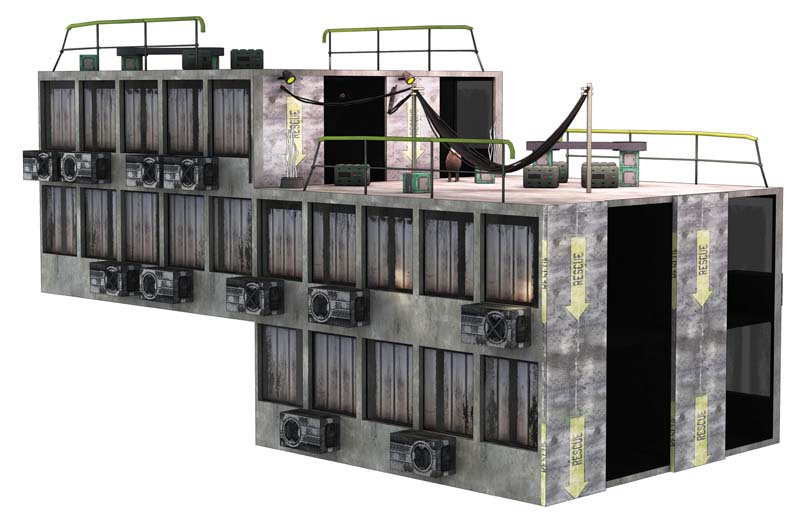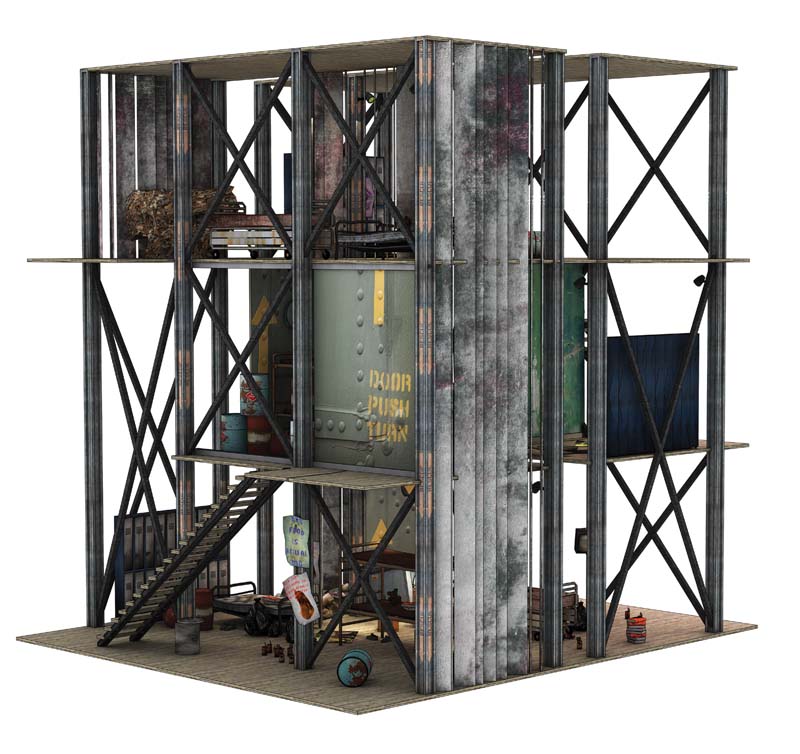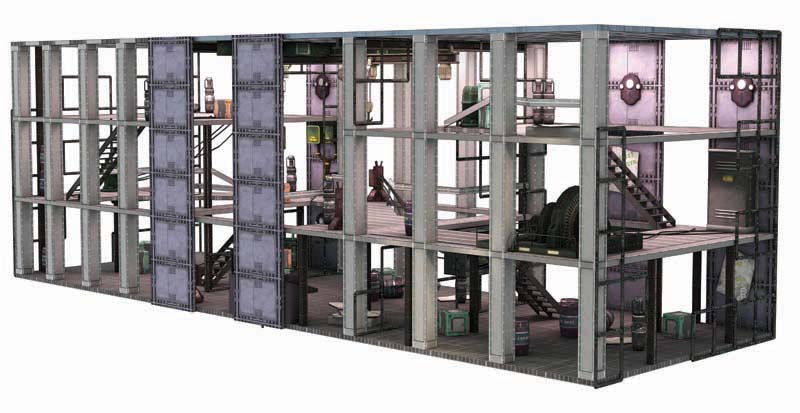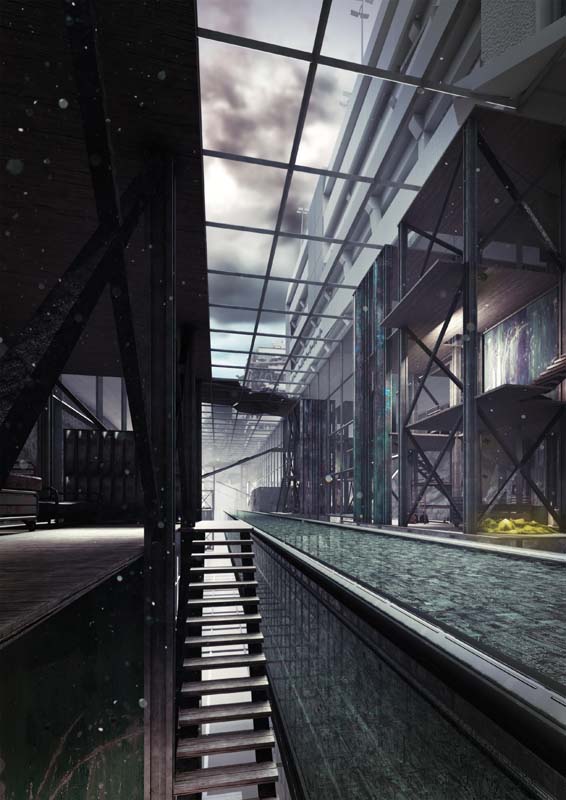

The development of each city is unique, so is the case of Tirana. But here, it seems the development of to be determined exclusively by the political events that took place since her foundation, but especially in the last one hundred years. In such a short time it has suffered extreme political, social and consequently urban changes.
This thesis concerns the analysis of these changes in the depiction of the city and especially in the area northeast of the center. The selected study area spreads around the spot where was found the old bazaar of Tirana and is the founding core, consequently prevents strong elements from periods of Othomanokratias Italokratias of the dictatorship culminating in the operations of the last twenty years. This area is characterized by informality, a large proportional residential use, many informal business activities and important urban voids: lack of public space, lack of green component, problematic roads.
The design proposal includes the redesigning of the road system, consequently the creating of blocks, it focus in appoint in of the area with an extent of 0.11 km2 with the designing of a building program that includes housing, office buildings, shops, cultural center and green spaces the element deficiency is so obvious throughout the whole the region.
Supervisor: Trova Vasso
Reference Number: 582












Having Philip K. Dick’s book "Do Androids Dream of Electric Sheep?" as a reference, and interpreting the core descriptive and narrative elements of his environment, a new adaptation of the story is examined through a videogame’s interactive environment. The primary intent of this adaptation is to clarify all the hidden meanings inside his imaginary world but also transform them into architectural form, capable of reminding but not duplicating Dick’s world. The social structure, the inner dilemmas of the major character as well as the double-standard of the human-machine constitute the basis of this procedure.
The social structure is expressed both in the environment as a whole and in each unit contained in it, evidently composing the narrative context of the game. The user’s self - identification with the major character of the book and his inner challenges is enabled through controlling an unknown avatar inside the game, following its efforts to identify visual stimuli. The existence of the human-machine double-standard is recognized both in the nature of the digital world and its elements of simulated reality, as well as inside the progress of the game’s plot.
By utilizing an alternate means of narration and representation of architectural space, the relationship between architecture and its notional output is facing a new approach as the narrative elements depend on interaction and rely on the user’s willingness to explore this new virtual environment.
Supervisor: Papadopoulos Spiros
Reference Number: 609


On March 13th of 2015, the Minister of Housing of Egypt announced one of the most ambitious infrastructural projects worldwide, the construction of a New Capital of the country. The New Capital, which has not been given yet an official name, will be located at a non-developed area of the east desert, between Cairo and Suez, will occupy a total area of 700 square kilometers, will host 5 to 7 million people and will be built within five years. This city will be financed exclusively by private capital. This announcement has caused a series of questions, which can’t be answered easily. How is a new city established in the 21st century, how can it be constructed from scratch and how will this city be transformed into a Capital? How will it be completed in such a short time and how will the ownership structure, which is implied in the announcement, affect the public space and the everyday life in this new city? Why to build a new capital today? Occasioned by these questions and the example of Egypt, a comprehensive study is carried out in this diploma project which aims to the fundamental and critical understanding of the New Capital. This study contains other international examples and an extensive mapping of the fundamental ways of production of space in Egypt, while a correlation is attempted between the political situation of this country and the architecture and the spatial management from 1952 until today.
Supervisor: Papadopoulos Lois
Reference Number: 580


This thesis is focusing on the human body and the way it interacts with its environment, and is attempting to create a structure that explores the limits of the movement.
The research is mainly based on the practice of playing which consists a way of release and on the way the human body behaves being on inclined surfaces.
The creation of a new terrain which implicitly develops a playful mood and challenges the limits of human movement becomes the main designing intention of this project.
Our intervention takes place in the campus of Polytechnic School of University of Thessaly. It is estimated that this kind of structure can constitute a core of alternative amusement and exercise being used by those who undergo the weekly academic procedure and whose bodies submit a physical predetermination. The new terrain attempts to incorporate the already existing needs as the parking and at the same time activities like playing, exercising.
Following a method of manual parametricism which includes a grid, different degrees of inclination adapted to it and its division in triangles, the structure ends up being composed by triangular surfaces and provides parking space, a restaurant and playgrounds.
Supervisors: Gavrilou Evelyn, Trova Vasso
Reference Number: 604


This dissertation aims at the construction of a New Business Park at the “Western Entrance” of Thessaloniki mainly through the design and study of a 32-storey skyscraper (123 metres tall) that will enclose tertiary sector “open space” style offices at its core, innovative hi tech branches and commercial spaces at its 3-storey base, and a luxury hotel at its finial.
The Western Entrance is located at the Lahanokipi Western border between the Municipalities of Thessaloniki and Menemeni. It forms the city entrance which leads up to the historic-commercial centre of Thessaloniki. Environmental degradation is noticeable throughout the area and a wide range and incompatibility of land use is recorded.
With regard to the skyscraper’s architectural design, its structural system that defined its architectural structure, its interior function, and finally its aesthetic quality and form, played a vital role. Its various chamfered angles that are formed by the wire mesh make the building appear asymmetrical and along with its cladding of specular glass innumerable reflections of the surrounding area are created. Special attention was paid during the design of the skyscraper so as to avoid an “island” style building that stands isolated behind all sides of the plot. For this reason, an additional building was designed and added around the skyscraper, which will be used for recreation-entertainment purposes giving further urban use to its floor level.
Finally, the Recreation Centre combined with the suggested two “sunken plazas” and greenery areas form a business park that depicts the optimism for the development and upgrade of the western entrance area. It is a large-scale endeavour, with aesthetic interventions, financial and general revitalisation of the area’s urban net.
Supervisor: Adamakis Kostas
Reference Number: 611


The conditions that characterize contemporary urban life is the displacement, exile, poverty and homelessness. Personal existence is recognized independently of the settlingin a place.
Garments,as temporary habitation spaceof the body, redefines constantlytheirposition sincebody constantly redefines its sitereference. In this sense, the garment is a structure that could redefine the boundaries between clothing and the built environment.
The proposal of this thesis is to design a wearableshelter whichis easy to transport. A portable habitation environment, designed for the mobility of nomadic populations.
For this work the following working scenarios weregenerated.
Senario_01
Syrian immigrant "of the days" goes along with his family, through the Mediterranean Sea, to settlein the richest countries of Europe.
Senario_02
Homeless resident of Athens movesdaily for its survival and protection.
Senario_03
Contemporaryflaneurof the world craves for adventure and experienceswith the least possible cost.
The “retreat” based on a light wooden frame that is sewn within the lining of the garment and has the ability to "open" and create space based on the mechanism of split umbrella. With the addition of two U-shapedtracks tothe central axis of the frame, it is hungedfrom the body.
The construction is worn alongwith the shell to which the synthetic Tyvek fabric is used, and the supportive frame of the tentis stored so as not to prevent the movement of the person. The conversion is made while the coat is still worn by the user.
The final form of thisproduct resultsfrom the ability of the nomad to gather the shelter in case of emergencyand to easily carry it with him bywearing it.
Supervisor: Gavrilou Evelyn
Reference Number: 585


In a city, like Volos, where college students are a big percentage of its population, from widely different and varying college departments, the search for suitable places to study is of even bigger importance than usual, let alone a place where they can also find a vast amount of information with which to further they knowledge.
The demand for activities, events and lessons that these young people have make evident a need for the construction of a building that will manage to accommodate all the above activities and please them as a center for reading, studying, contemplation, communication, socialization, entertainment and learning that will be open 24 hours a day.
The third and last demand for such a place is for it to have the latest technological support for all these activities, as in the age of information studying has surpassed the limits of a traditional book and a traditional library. Under that light, it is imperative that it contains a digital archive that contains a collection of movies, paintings, exhibits and audio recordings. As it is easily understood the appropriate equipment to reproduce these files as well as the proper training to organize and maintain such an archive will be needed.
In the effort to understand the relations that are created and to satisfy the afore mentioned demands we have to organize in a certain form of society, with certain specific limitations and freedoms.
The building is reformed in such a way that its spaces can be constantly reorganized to fit the ever-changing needs of its visitors, as well as being able to accommodate them 24hours a day.
Lastly, the outcome of this effort will include a lending library, access to the internet, and spaces for seminars, film projections, cooking lessons, presentations, reading rooms, exhibitions, concerts, digital audiovisual presentations and a lot of free spaces able to accommodate the visitors and to be used for any other activities.
Supervisor: Stylidis Iordanis
Reference Number: 577


The current project concerns the reutilization of a former cement factory AGET (ΑΓΕΤ) located at Mikro Vathi at the area of Avlida. Τhe area of study is a focal point as it unites Central Greece with the island of Evia and borders with sites of archaeological interest and croplands.
More specifically, the selected site is located at the entrance of the city of Chalkida and includes the historic area of Avlida. The latter, now houses the remains of the sacred temple of Artemis, which was the gathering and starting point of the Achaean fleet to the Trojan war. The mainland part of Central Greece also includes the region of Ritsona - the origin location of retsina drink, which ranks second place for the extent of its vineyards in our country.
Based on the foregoing, the basic idea of our project focuses on maintaining majority of the buildings and preserve them as exhibition object for future development. Within the recommended reuse project the planning of a new winery is included, which will also house various public functions. The proposal is accompanied by the planting of vineyards and the creation of a public landscape square within the plot, in order to restore the contaminated soil from the former industrial activity. Moreover, in some buildings of the complex is given an indirect museological approach and thus providing the general public with the chance to visit and get informed of the manufacturing equipment and the story of ΑGET.
In conclusion, the creation of a winery in this location is supposed to form a bridge between Ritsona and Evia which are both important destinations of Vinitourism, as they produce different varieties of wine. Through our project we would like to suggest a way of making use of the "Industrial rubbles", most of which are left to decay after their closure, despite the fact that they formed an important role in the development of Greek cities in the past.
Supervisor: Trova Vasso
Reference Number: 594

